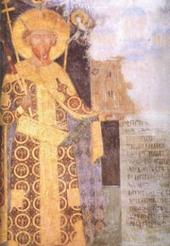Myspace Layouts at Pimp-My-Profile.com / Lounge deluxe
Stefan Lazarević (Serbian Cyrillic: Стефан Лазаревић; 1374 – 19 July 1427) was a Serbian Despotes. He was the son and heir to Prince Lazar (Serbian: Knez Lazar, Кнез Лазар), who died at the Battle of Kosovo against the Turks in 1389, and Princess Milica (Милица) from the subordinate branch of the Nemanjić (Ðемањић) dynasty. His reign and his personal literary works are sometimes associated with early signs of the Renaissance in Serbian lands. Despot Stefan was a poet and a moderniser. He introduced knight tournaments, modern battle tactics, and firearms to Serbia. Stefan became Prince in 1389, and participated as an Ottoman vassal in the Battle of Karanovasa in 1394, the Battle of Rovine in 1395, the Battle of Nicopolis in 1396, and in the Battle of Ankara in 1402. He became the Despot of Serbia in 1402 after the Ottoman state temporarily collapsed following Timur's invasion of Anatolia with the Battle of Ankara, and in 1403 proclaimed Belgrade his capital. He built a fortress with a citadel which was destroyed during the Great Turkish War in 1690; only the Despot Stefan Tower remains today. Stefan defeated and killed his brother-in-law Bayezid I's son Musa during the Battle of Despotovac in 1406. After the battle, Serbia had peace with the Ottomans for a long time. Despot Stefan Lazarević's Coat of Arms, 1415 AD Despot Stefan Lazarević's Coat of Arms, 1415 ADStefan II became an ally of the Kingdom of Hungary and a knight of a special order, so when the Hungarian king Sigismund renewed the Order of the Dragon (Societas draconistrarum) in 1408, Despot Stefan Lazarević was the first on the list of members. In 1404, Sigismund gave Lazarević land in the present-day Vojvodina (and Pannonian part of present-day Belgrade), including Zemun (today part of Belgrade), Slankamen, Kupinik, Mitrovica, BeÄej, and Veliki BeÄkerek. In 1417, Apatin is also mentioned among his possessions.Under his rule, he issued a Code of Mines in 1412 in Novo Brdo in Kosovo, the economic center of Serbia. In his legacy, Resava-Manasija monastery (Pomoravlje District), he organized the Resava School, a center for correcting, translating, and transcribing books.Stefan Lazarević died suddenly in 1427, leaving the throne to his nephew ÄuraÄ‘ Branković. His deeds eventually elevated him into sainthood, and the Serbian Orthodox Church honors him on August 1st. Despot Stefan is buried in the monastery Koporin which he has had built, as he did the bigger and more famous Manasija monastery. In fact, Manasija was intended as his own burial place, but due to a sudden nature of his death in perilous times it was his brother Vuk that is burried there. Apart from the biographical notes in charters and especially in the Code on The Mine Novo Brdo (1412), Stefan Lazarević wrote three original literary works: The Grave Sobbing for prince Lazar (1389); The Inscription on the Kosovo Marble Column (1404); and A Homage to Love (1409), a poetic epistle to his brother Vuk.